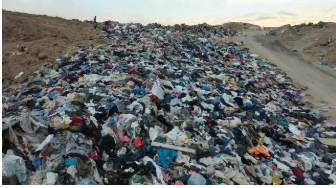With the rise in popularity of fast fashion, consumers are unknowingly contributing to the climate change crisis and the destruction of the environment.
Fast fashion is the term used to describe the rapid production of inexpensive clothing to meet current trends in the media. In the last 20 years, fast fashion has become a dominant force in the global fashion industry, with companies like Shein and Zara dominating the charts in terms of global popularity and revenue. According to Prioridata.com, in 2024, Shein pulled in about 48 billion dollars in revenue, and it’s expected to jump up to an extraordinary 56 billion by the end of 2025.
Fast fashion is so lucrative because it’s cheap, and the options feel limitless; now consumers have a wider range of variety in styles and sizing for less money. In addition to this, fast fashion is also extremely convenient. Sazhi Songo, junior, said, “I think fast fashion is really harmful to the environment, but I can see why people shop fast fashion due to its affordability.” Buyers can now shop online and have their clothes delivered to their doorstep, rather than going to the actual store and wasting hours shopping for clothes. While fast fashion offers consumers the allure of trendy, affordable apparel, the environmental costs are significant and alarming.
One significant issue that comes with the mass production of clothing is its contribution to greenhouse gas emissions. The production, transportation, and disposal of clothing requires a substantial amount of energy consumption, primarily fossil fuels. Approximately 1.2 billion tonnes of carbon emissions are released each year by the fast fashion industry, accounting for 10 percent of global pollution. When producing clothing, certain materials release more greenhouse gasses; for example, polyester clothing requires more energy to manufacture as opposed to cotton clothing. Factors such as excessive energy consumption and more carbon emissions being released into the atmosphere are accelerating global warming at an alarming rate.
Another major concern about fast fashion is the destructive impact on the environment. Excessive clothing waste is over-running landfills. Approximately 85% or 11.3 billion tons of clothing end up in landfills each year, according to Earth.org. The decomposition rate of textiles can vary from weeks to hundreds of years. While that may sound like a good thing, in reality, when clothing decomposes, it releases toxic dyes and chemicals into the environment, possibly harming groundwater and soil. Speaking of clothing decomposition, when a synthetic piece of clothing starts to break down, it can’t do so properly, leaving behind microplastics. Microplastics are polluting the oceans, harming sea life, and ultimately hurting humans. The National Institute of Health claims, “Ingestion of food and water contaminated with microplastics is the main route of human exposure.” The risks associated with ingesting microplastics include cancer, heart disease, autoimmune and other health problems.
In short, the environmental impacts of fast fashion are alarming and far-reaching. From the overuse of natural resources to overwhelming landfills with textile waste, to contributing to climate change. The fast fashion industry poses a serious threat to the environment. The next time consumers are thinking about buying fast fashion, they should consider the threat it poses to the planet.











































Javier Parra (Kylie's biggest Fan) • May 1, 2025 at 11:45 am
This was a fantastic article Ms. Schoellgen!